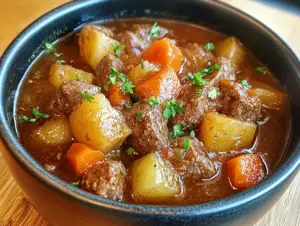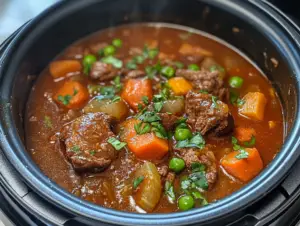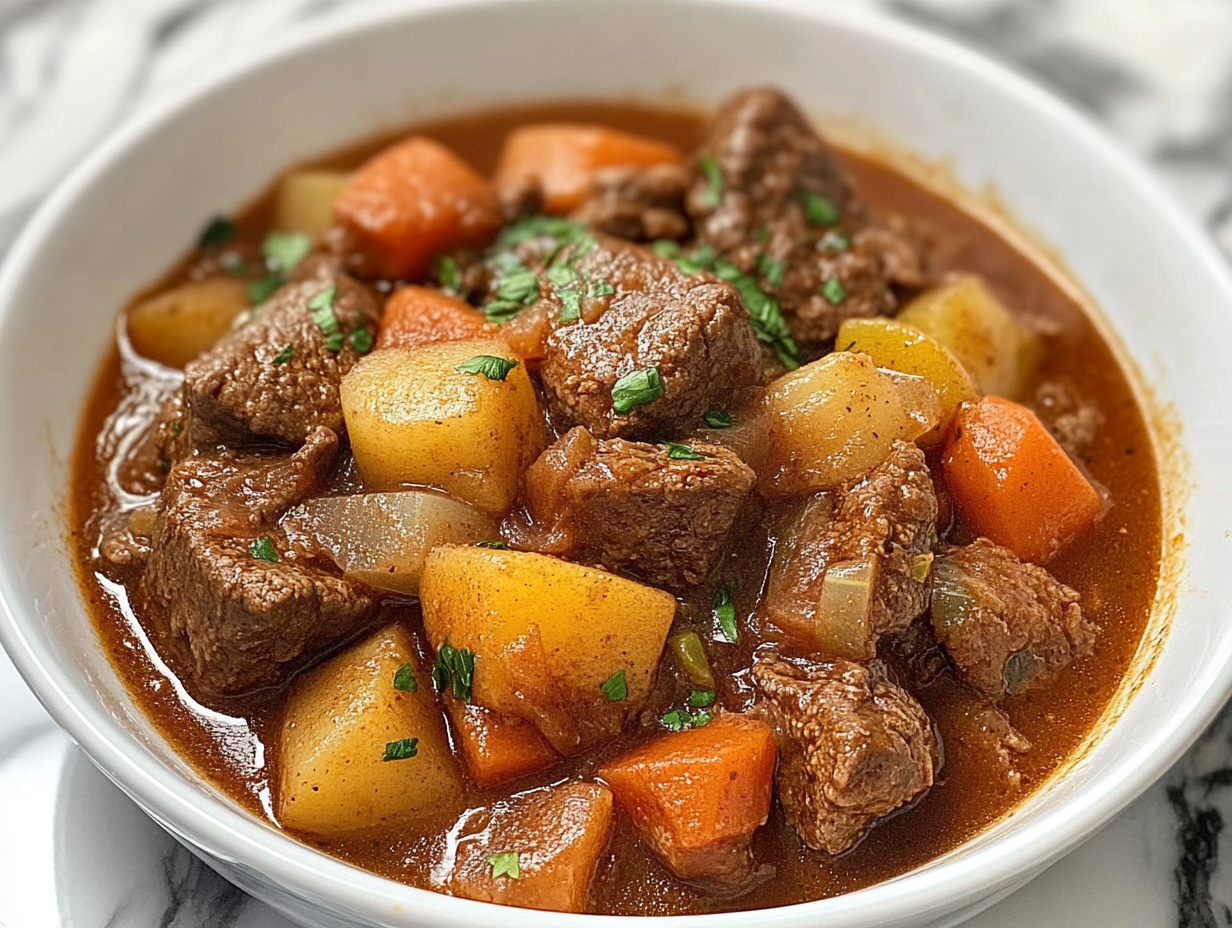The Ultimate Guide to Making Beef Stew in an Instant Pot
Beef stew is a comforting, hearty dish that’s perfect for any season, especially during colder months. Traditionally, making beef stew could take hours, requiring you to slow-cook the beef until it becomes tender and all the flavors meld together. However, using an Instant Pot changes the game, offering a faster and more efficient way to achieve the same delicious results. This guide will walk you through the best techniques, tips, and variations for making a mouthwatering beef stew in your Instant Pot.
Why Use an Instant Pot for Beef Stew?
The Instant Pot has revolutionized the way we cook by combining the functions of multiple kitchen gadgets into one. But why is it especially great for beef stew?
- Speed and Efficiency: The Instant Pot drastically reduces cooking time, bringing you from prep to plate in under an hour compared to the hours needed for traditional stovetop or slow-cooking methods.
- Enhanced Flavors: Pressure cooking in an Instant Pot locks in all the rich flavors and juices, making your stew taste as if it’s been simmering all day.
- Versatility: You can sauté, pressure cook, and even thicken your stew in one pot, minimizing cleanup and making the cooking process straightforward and easy.
If you’re new to the Instant Pot, you might want to read this Instant Pot Guide to familiarize yourself with the different settings and tips for best results.
The Best Cuts of Beef for Stew
Choosing the right cut of beef is crucial for making the perfect stew. For the best results, opt for cuts that become tender and flavorful through slow, moist cooking methods, such as:
- Chuck Roast: The most popular choice for beef stew due to its balance of marbling and tenderness when cooked.
- Brisket: Adds a rich flavor but requires slightly longer cooking.
- Short Ribs: These can add extra flavor and are great if you prefer a meatier, more substantial texture.
To explore more about the best cuts of beef for stew, you can check this comprehensive guide.
Essential Ingredients for Instant Pot Beef Stew
Before you start cooking, gather all the essential ingredients. Here’s what you’ll need:
- Beef Chuck Cubes: Aim for about 2 pounds, cut into 1-inch pieces.
- Potatoes: Russets or Yukon Golds are ideal; they hold their shape and absorb flavors well.
- Carrots and Celery: These add sweetness and texture to the stew.
- Onions and Garlic: For a depth of flavor.
- Beef Broth: Provides the liquid base and adds a rich, beefy flavor.
- Tomato Paste: For acidity and a slightly sweet undertone.
- Worcestershire Sauce: Enhances the umami in the stew.
- Flour or Cornstarch: Used as a thickener at the end of the cooking process.
- Salt, Pepper, and Fresh Herbs (Rosemary, Thyme): Essential seasonings to elevate the dish.
Tools and Equipment
Having the right tools on hand ensures a smooth cooking experience:
- Instant Pot: A 6-quart model works well for most stew recipes.
- Wooden Spoon: Ideal for stirring without scratching the pot’s inner surface.
- Measuring Cups and Spoons: For accurate seasoning and liquid measurements.
Step-by-Step Instructions for Instant Pot Beef Stew

1. Prep the Ingredients
Start by preparing all your ingredients. This includes cutting the beef into uniform cubes, chopping vegetables, and measuring out liquids and seasonings.
- Cut the Beef: Trim excess fat from the beef chuck, then cut into 1-inch cubes.
- Season the Beef: Sprinkle the cubes with salt and pepper for added flavor before cooking.
- Chop Vegetables: Dice potatoes, carrots, and onions into even pieces to ensure they cook uniformly.
2. Sauté the
Using the Sauté function on your Instant Pot, heat a tablespoon of oil or butter.
- Brown the Beef: Add the beef cubes in a single layer, browning them on all sides. This step is crucial as it develops the rich, deep flavor that defines a good stew.
- Deglaze the Pot: After browning, add a splash of beef broth to deglaze the pot, scraping up all the flavorful browned bits stuck to the bottom.
3. Add the Vegetables and Liquid
With the beef still in the pot, add your chopped vegetables, garlic, and onion.
- Pour in Beef Broth: Add enough broth to just cover the meat and vegetables, usually about 4 cups.
- Mix in Tomato Paste and Worcestershire Sauce: Stir well to combine. This blend of flavors adds depth and complexity to the stew.
4. Pressure Cook the Stew
Secure the lid on the Instant Pot and ensure the pressure release valve is set to “Sealing.”
- Set the Instant Pot to Meat/Stew Mode: Cook on high pressure for 35 minutes. It may take 10-15 minutes for the pressure to build before the timer starts.
- Natural Release: Once cooking is complete, let the pressure release naturally for about 10-15 minutes. This step allows the flavors to meld together beautifully.
5. Thicken the Stew
To achieve the perfect consistency, you may need to thicken your stew.
- Make a Slurry: Mix 2 tablespoons of cornstarch with 2 tablespoons of water until smooth.
- Add to Stew: Set the Instant Pot to Sauté mode, stir in the slurry, and let the stew simmer for a few minutes until thickened.
Common Mistakes and How to Avoid Them
Even seasoned cooks can run into issues when making stew. Here’s how to sidestep the most common mistakes:
- Skipping the Browning Step: Browning adds a layer of flavor you can’t achieve any other way. Don’t skip it!
- Using Too Much Liquid: The Instant Pot needs less liquid than traditional methods. Stick closely to the recommended amount to avoid a watery stew.
- Overcooking the Vegetables: Cut vegetables into larger chunks to prevent them from turning to mush.
Customizing Your Instant Pot Beef Stew
While the classic recipe is delicious, there are plenty of ways to make your beef stew your own:
- Add Different Vegetables: Try adding green beans, peas, or mushrooms for added texture and flavor.
- Adjust the Seasonings: Feel free to adjust the herbs and spices to suit your taste. Bay leaves, thyme, or smoked paprika can provide an extra depth of flavor.
- Substitute the Beef: Swap out the beef for lamb or even chicken for a different take on the traditional recipe.
Serving Suggestions
Serving your beef stew creatively can elevate the dining experience, turning a simple dish into a memorable meal. Here are some ideas to complement and enhance your beef stew:
1. Serve with Crusty Bread
- Why It Works: The rich and savory broth of the beef stew pairs perfectly with crusty bread. It’s ideal for soaking up every last bit of the delicious sauce.
- Suggestions: Serve with a warm baguette, sourdough, or a slice of garlic bread for added flavor.
2. Over Mashed Potatoes
- Why It Works: The creamy texture of mashed potatoes balances the hearty, chunky consistency of the stew, making each bite smooth and satisfying.
- Suggestions: Use buttery mashed potatoes or even garlic mashed potatoes to add an extra layer of flavor to your meal.
3. With Rice or Quinoa
- Why It Works: Stew served over rice or quinoa is a great way to soak up the flavors while adding a hearty grain component to the dish.
- Suggestions: White rice, brown rice, or quinoa work well, and they can easily be flavored with a bit of butter and herbs to complement the stew.
4. Egg Noodles or Pasta
- Why It Works: Serving beef stew over egg noodles or a wide pasta like pappardelle adds a comforting, carb-rich base that pairs wonderfully with the stew’s savory sauce.
- Suggestions: Egg noodles add a softer, richer texture, while pasta like pappardelle gives a rustic feel to the dish.
5. Side Salad
- Why It Works: A light, crisp side salad adds freshness and a contrasting texture to the warm, hearty stew. It’s also a great way to add some greens to the meal.
- Suggestions: A simple salad with mixed greens, cherry tomatoes, cucumber, and a light vinaigrette works well. Consider adding croutons for extra crunch.
6. Polenta
- Why It Works: Creamy polenta pairs beautifully with beef stew, providing a buttery, slightly sweet base that complements the stew’s rich flavors.
- Suggestions: Serve the stew over soft polenta for a comforting, Italian-inspired twist.
7. Dumplings
- Why It Works: Adding dumplings to beef stew makes it an even more filling and comforting meal, turning it into a classic homestyle dish.
- Suggestions: Light, fluffy dumplings cooked directly in the stew absorb the flavors and provide a satisfying, doughy component.
8. Garnishes for Extra Flavor
- Fresh Herbs: A sprinkle of chopped parsley, thyme, or chives can brighten up the dish and add a touch of freshness.
- Sour Cream or Greek Yogurt: A dollop on top of each bowl adds creaminess and a slight tang that balances the richness of the stew.
- Grated Cheese: Parmesan or cheddar can be sprinkled on top for added richness and a cheesy finish.
9. Wine Pairing
- Why It Works: Beef stew pairs wonderfully with red wine, enhancing the flavors of the dish.
- Suggestions: Opt for robust reds like Cabernet Sauvignon, Merlot, or Malbec to complement the stew’s hearty flavors.
10. Serving in Bread Bowls
- Why It Works: Bread bowls add a fun and unique presentation that’s both practical and delicious, as the bread absorbs the stew’s rich broth.
- Suggestions: Hollow out sourdough or round rolls, ladle in the stew, and enjoy the flavorful bread as you eat.
Storage and Reheating Tips

Proper storage and reheating are key to enjoying your beef stew even days after it’s made. Here are some tips to ensure your stew remains flavorful and safe to eat:
Storing Beef Stew
- Refrigeration: Allow the stew to cool down to room temperature before storing. Place it in an airtight container and store it in the refrigerator for up to 4 days. This helps maintain the flavor and prevents bacterial growth.
- Freezing: Beef stew freezes exceptionally well, making it perfect for meal prep. Pour the cooled stew into freezer-safe containers or heavy-duty freezer bags, leaving some space for expansion. Label with the date and freeze for up to 3 months.
Reheating Beef Stew
- Stovetop: Reheating on the stovetop is the best way to maintain the stew’s texture and flavor. Pour the stew into a pot and heat over medium heat, stirring occasionally, until it reaches a simmer. If the stew is too thick, add a bit of beef broth or water to loosen it up.
- Microwave: For a quick reheat, use the microwave. Transfer a portion of the stew into a microwave-safe bowl, cover with a lid or microwave-safe wrap, and heat on high in 1-2 minute intervals, stirring in between, until fully heated. Be careful as the stew may heat unevenly; stirring helps distribute the heat.
- Instant Pot Reheat: You can also reheat your stew using the Instant Pot. Pour the stew back into the pot, set to Sauté mode, and stir frequently until warmed through. Alternatively, use the Keep Warm function if you’re reheating a large batch.
Additional Tips
- Avoid Overcooking: When reheating, be mindful not to overcook the stew, as this can make the meat tough and vegetables mushy.
- Adjust Consistency: If the stew thickens too much after storage, add a splash of beef broth, water, or even a bit of red wine to bring it back to your desired consistency.
- Taste Before Serving: After reheating, give your stew a taste. You may need to adjust the seasoning, especially if adding extra liquid during reheating.
FAQs About Instant Pot Beef Stew
How long does it take to cook beef stew in an Instant Pot?
The cooking time is 35 minutes at high pressure, plus additional time for pressure build-up and release, making the total time around 60-70 minutes.
Can I use frozen beef?
Yes, you can use frozen beef, but you’ll need to add about 10 minutes to the cooking time. Make sure to adjust the seasoning afterward.
What’s the best way to thicken beef stew?
Cornstarch, flour, or potato starch are excellent thickeners. Mix them with cold water before adding them to the stew to prevent lumps.
Can I make this without an Instant Pot?
Absolutely! You can adapt this recipe for a slow cooker or stovetop. Keep in mind that the cooking time will be much longer (6-8 hours on low for a slow cooker).
What are some good side dishes for beef stew?
Serve your stew with crusty bread, over rice, or alongside a simple green salad to balance the meal.

